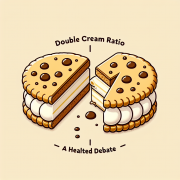Investigating the Mystery Behind Double Stuf Oreos: A Mathematics Approach
The Curious Case of the Shrinking Oreo Double Stuf
Brands often find themselves in the spotlight for various reasons, but when a company as iconic as Oreo is accused of skimping on the very essence of what makes its Double Stuf cookies doubly delightful, it’s bound to stir up emotions. A recent outcry on social media, spearheaded by a TikTok from user @littlevirgrow, has reignited a long-standing question: Has the amount of icing in Double Stuf Oreos decreased over time?
The embattled TikToker showcased what appeared to be less-stuffed Oreos, expressing disbelief and disappointment over the reduced cream filling, a sentiment echoed by many in the comments section. The issue at hand isn’t just about cookies; it’s about customer trust and the perceived value of a product that many have loved for years.
A Mathematical Inquiry into Oreo’s Filling
The Double Stuf Oreo controversy isn’t new. It harks back to a mathematical exploration conducted by a high school math teacher and his students in 2013. Their findings, which suggested that Double Stuf Oreos might not actually contain double the stuff, adds an intriguing layer to the discussion.
As someone deeply involved in the realms of mathematics and technology, I find this mathematical approach to consumer advocacy both fascinating and necessary. Mathematical literacy empowers individuals to question and analyze the world around them, including the products they consume.
< >
>
Mondelez International’s Stance on Oreo’s Filling
Despite the uproar, Mondelez International, the parent company of Oreo, stands by its product. The company’s CEO, Dirk Van de Put, has emphatically denied any change in the cream-to-cookie ratio, which is a significant assertion considering the current climate of rising ingredient costs. The company has acknowledged actions like raising prices and reducing package sizes to combat these costs, but remains firm on maintaining product quality.
This scenario is a classic example of the consumer-brand trust dynamic. As businesses navigate the complexities of market demands, cost pressures, and consumer expectations, maintaining transparency and quality becomes paramount.
Consumer Advocacy in the Digital Era
The power of social media as a platform for consumer advocacy cannot be understated. A single video on TikTok has sparked a widespread conversation, highlighting how digital tools enable consumers to hold brands accountable. This democratization of brand scrutiny is a double-edged sword, amplifying both legitimate concerns and unfounded claims. Thus, navigating the digital landscape requires a discerning eye and a critical mind.
< >
>
Connecting the Dots: From Number Theory to Consumer Rights
Reflecting on previous discussions on my blog, especially those pertaining to the importance of mathematics in everyday life such as number theory, it’s evident how mathematical principles can play a role in consumer rights. The examination of Oreo’s filling is not just about a cookie; it’s a lesson in the practical application of mathematics—measuring, comparing, and analyzing to seek truth and justice in the marketplace.
Just as we use mathematics to uncover the mysteries of the universe, we can employ these skills in our daily lives to make informed decisions and hold corporations accountable. Whether it’s calculating the real value of a “double stuffed” cookie or analyzing the implications of shrinkflation, mathematics is an invaluable tool in our quest to navigate the complex world around us.
<
>
Conclusion
The debate over Double Stuf Oreos serves as a microcosm of larger conversations about product integrity, consumer expectations, and the role of mathematics in everyday advocacy. As we continue to seek fairness and transparency in all aspects of life, let us not underestimate the power of numbers to reveal truths and challenge the status quo.
As we navigate these discussions, let’s remember the importance of staying informed, asking questions, and using the tools at our disposal to uncover the real “stuff” that matters.




Hey everyone, David here. I decided to delve into the Double Stuf Oreos controversy not just because it’s a quirky topic, but to highlight the broader importance of mathematical literacy in our everyday lives. Whether we’re questioning the integrity of a beloved cookie or examining broader market practices, mathematics is a powerful tool for empowerment in our roles as informed consumers. I hope this piece encourages you to look closer at the world around you and question the status quo. Let’s keep the conversation going in the comments!
I stumbled upon this article with a mix of curiosity and skepticism. As someone a bit wary of where AI and technology are taking us, I appreciated the grounding in mathematics as a means to hold big companies accountable. It’s a reminder of the power of critical thinking in a digital age. And while I’m all for questioning the integrity of what we consume (whether it’s food like Oreos or information online), I’m hopeful about harnessing technology for transparency rather than deceit. Plus, who knew Oreos could spark such a deep conversation? P.S. Love the shoutout to math – my favorite subject back in school! – Hope from Florida